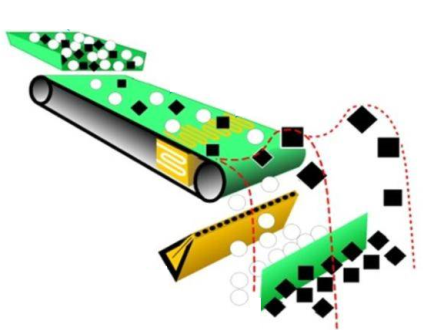
SMART DOG MININGTM
It
takes a smart dog to find hidden treasures
Introduction to Dry Mineral Processing

A major issue in the world, and directly
effecting the mining industry is water or rather lack of water.
Rivers are running dry causing economic impacts and
humanitarian issues in many parts of the world.
Many, say most, mining and mineral processing operations
require water. Even
with best practices water scarcity is becoming a problem.
An
alternative is dry mineral processing.
This falls into two general categories: sorting and pneumatic
or air separation.
SORTING

One of the earliest, if not the earliest,
methods of mineral processing was sorting.
This made use of the difference in color, luster, or similar
property of one mineral from another.
This (along with gravity) remained the main method of
concentration until the later parts of the 19th century (and for
some minerals well into the 20th), primarily by doing hand sorting.
Even today hand sorting is often the final stage for small
artisanal mining and prospecting (selecting diamonds by eye and
picking gold from the pan).
Today sorting has also grown beyond this and
expanded to become commercial operations using how minerals react to
electromagnetism.
Electromagnetism has three properties all of which are used in
mineral processing: electric fields, magnetic fields, and
electromagnetic radiation (light).
Electrical Fields
Some minerals are relatively good conductors,
while others are relatively poor conductors of electricity.
This can be used to separate them. Most of the sulphide
minerals and most metals are, to some extent, conductors of
electricity, while the gangue minerals are generally poor
conductors. If ore particles
are brought into contact with an electrode containing a charge, the
better conductors become similarly charged and are repelled, in the
same way that pith balls would be under like conditions, while the
poorer conductors are not repelled or at least not as far.
Magnetic Fields
Attraction to a magnet is quite strong in some
minerals and metals; particularly magnetite, some forms of
pyrrhotite, cast iron, wrought iron, steel, nickel, and cobalt.
Other minerals, such as franklinite, chromite, or iron-bearing
sphalerite, garnet, etc., have very weak magnetism. Still others,
such as quartz, calcite, gypsum, feldspar, etc., exhibit no
attraction at all. This
property may be used to separate the magnetic from the non-magnetic.
Electromagnetic
Radiation
Under the stimulation of electrical magnetic
radiation, some minerals have distinctive optical properties.
The easiest to observe are color and luster which was (and
is) used in hand picking and optical sorting.
Slight differences in color
or in luster - for instance, the brass yellow of chalcopyrite, the
pale yellow of pyrite, the vitreous luster of quartz, the resinous
of sphalerite, the adamantine of diamond, the dull of chalk, and the
pearly of talc can furnish aids in hand picking and can be used for
optical sorting.
Further on in the spectrum particular under ultra-violet or even on
to x-rays, mineral fluorescence is used to sort.
Sorting as a Process
Sorting, particularly mechanized sorting,
requires the material to be between 1 mm and 20 microns in particle
size, and in feed rates of 150 tons per hour or less.
For sorting to be effective, and its major limitation, is
that the ore and the waste material must be well liberated in the
feed to the sorter (that is into practically discrete particles of
ore and waste). The larger the liberation size the more likely
sorting is to be cost effective.
Picking the correct ore sorting equipment for
an operation is important and often special machine features are
developed for an individual application.
As with any process, and more so than some, good sorter
performance requires extensive test work.
Often using prototype or preferably on production model
sorting machines at close to design tonnages and conditions as
possible.
If set-up and used properly, a high grade
concentrate can be produced, but recovery may suffer due to blocked
or locked particles.
PNEUMATIC
CONCENTRATORS
Pneumatic
concentrators are those in which a gas, invariably air, is used to
effect differential movement of particles of different specific
gravities. They parallel the water-gravity concentrators In that
beds, quicksands, and the direct impulse of air on feed particles
are all utilized.
Bed-Type
Pneumatic Concentrators
In
settling rates of
particles in a pulsated bed of which they themselves are parts. The
group includes
all of the
pneumatic machines best known and most used. The essential elements
in all are a porous supporting
surface for a mass of grains; an air supply flowing upward through
the supporting surface and thence through the interstices of the
mass of
grains, means to
produce flow of the mass of grains and to constrain layers at
different vertical
depths therein to
move in different directions to different discharge points. These
are the essential elements
of a
water jig, except for the difference in interstitial medium.
The kind of stratification effected, with large, heavy
material of a given specific gravity at the bottom of the layer of
that material, is the same in both machines; the responses to
controls are, of course, also the same.
In other words, these apparatus, though having the general
form and appearance of shaking tables used for water-gravity
concentration, and
called pneumatic tables,
are actually pneumatic jigs.
Pneumatic
Quicksand
Blowing
Pneumatic
Gravity Equipment

Dry Washer (after West)

Air Table (after Forsberg’s
Inc.)

Air Jig (after Weitkaemper & Wotruba)

o
40+ years’ experience in the mining industry with strong mineral
processing experience in precious metals, copper, industrial
minerals, coal, and phosphate
o
Operational experience in precious metals, coal, and phosphate plus
in petrochemicals.
o
Extensive experience performing studies and determining feasibility
in the US and international (United States, Canada, Mexico, Ecuador,
Columbia, Venezuela, Chile, China, India, Indonesia, and Greece).
o
E-mail:
info@smartdogmining.com
